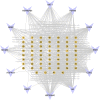Uncovering the Effect and Mechanism of Rhizoma Corydalis on Myocardial Infarction Through an Integrated Network Pharmacology Approach and Experimental Verification
- PMID: 35935870
- PMCID: PMC9355031
- DOI: 10.3389/fphar.2022.927488
Uncovering the Effect and Mechanism of Rhizoma Corydalis on Myocardial Infarction Through an Integrated Network Pharmacology Approach and Experimental Verification
Abstract
Background: Myocardial infarction (MI), characterized by reduced blood flow to the heart, is a coronary artery disorder with the highest morbidity and mortality among cardiovascular diseases. Consequently, there is an urgent need to identify effective drugs to treat MI. Rhizoma Corydalis (RC) is the dry tuber of Corydalis yanhusuo W.T. Wang, and is extensively applied in treating MI clinically in China. Its underlying pharmacological mechanism remains unknown. This study aims to clarify the molecular mechanism of RC on MI by utilizing network pharmacology and experimental verification. Methods: Based on network pharmacology, the potential targets of the RC ingredients and MI-related targets were collected from the databases. Furthermore, core targets of RC on MI were identified by the protein-protein interaction (PPI) network and analyzed with Gene Ontology (GO) analysis and the Kyoto Encyclopedia of Genes and Genomes (KEGG) pathway enrichment analysis. Molecular docking was used to validate the binding affinity between the core targets and the bioactive components. Oxygen-glucose deprivation (OGD) was performed on H9c2 cells to mimic MI in vitro. A Cell Counting Kit-8 assay was used to assess the cardioprotective effect of the active ingredient against OGD. Western blot analysis and RT-qPCR were used to measure the cell apoptosis and inflammation level of H9c2 cells. Results: The network pharmacology obtained 60 bioactive components of RC, 431 potential targets, and 1131 MI-related targets. In total, 126 core targets were screened according to topological analysis. KEGG results showed that RC was closely related to the phosphatidylinositol 3-kinase (PI3K)/Protein kinase B (PKB, also called Akt) signaling pathway. The experimental validation data showed that tetrahydropalmatine (THP) pretreatment preserved cell viability after OGD exposure. THP suppressed cardiomyocyte apoptosis and inflammation induced by OGD, while LY294002 blocked the inhibition effect of THP on OGD-induced H9c2 cell injury. Moreover, the molecular docking results indicated that THP had the strongest binding affinity with Akt over berberine, coptisine, palmatine, and quercetin. Conclusion: THP, the active ingredient of RC, can suppress OGD-induced H9c2 cell injury by activating the PI3K/Akt pathway, which in turn provides a scientific basis for a novel strategy for MI therapy and RC application.
Keywords: Corydalis yanhusuo; PI3k/Akt signaling pathway; apoptosis; myocardial infarction; network pharmacology; tetrahydropalmatine.
Copyright © 2022 Li, Wu, Huang, Cheng, Wang and Liu.
Conflict of interest statement
The authors declare that the research was conducted in the absence of any commercial or financial relationships that could be construed as a potential conflict of interest.
Figures










Similar articles
-
Integrated Serum Pharmacochemistry and Network Pharmacology Approach to Explore the Effective Components and Potential Mechanisms of Menispermi Rhizoma Against Myocardial Ischemia.Front Chem. 2022 May 19;10:869972. doi: 10.3389/fchem.2022.869972. eCollection 2022. Front Chem. 2022. PMID: 35665070 Free PMC article.
-
Erianin, the main active ingredient of Dendrobium chrysotoxum Lindl, inhibits precancerous lesions of gastric cancer (PLGC) through suppression of the HRAS-PI3K-AKT signaling pathway as revealed by network pharmacology and in vitro experimental verification.J Ethnopharmacol. 2021 Oct 28;279:114399. doi: 10.1016/j.jep.2021.114399. Epub 2021 Jul 8. J Ethnopharmacol. 2021. PMID: 34246740
-
Network pharmacology analysis and experimental validation to explore the mechanism of Shenlian extract on myocardial ischemia.J Ethnopharmacol. 2022 Apr 24;288:114973. doi: 10.1016/j.jep.2022.114973. Epub 2022 Jan 4. J Ethnopharmacol. 2022. PMID: 34990768
-
The Potential Effect of Rhizoma coptidis on Polycystic Ovary Syndrome Based on Network Pharmacology and Molecular Docking.Evid Based Complement Alternat Med. 2021 Jul 8;2021:5577610. doi: 10.1155/2021/5577610. eCollection 2021. Evid Based Complement Alternat Med. 2021. PMID: 34306142 Free PMC article. Review.
-
Advances in phytochemical and modern pharmacological research of Rhizoma Corydalis.Pharm Biol. 2020 Dec;58(1):265-275. doi: 10.1080/13880209.2020.1741651. Pharm Biol. 2020. PMID: 32223481 Free PMC article. Review.
Cited by
-
Mechanistic insights into the ameliorative effects of hypoxia-induced myocardial injury by Corydalis yanhusuo total alkaloids: based on network pharmacology and experiment verification.Front Pharmacol. 2024 Jan 11;14:1275558. doi: 10.3389/fphar.2023.1275558. eCollection 2023. Front Pharmacol. 2024. PMID: 38273838 Free PMC article.
-
Caizhixuan hair tonic regulates both apoptosis and the PI3K/Akt pathway to treat androgenetic alopecia.PLoS One. 2023 Feb 24;18(2):e0282427. doi: 10.1371/journal.pone.0282427. eCollection 2023. PLoS One. 2023. PMID: 36827412 Free PMC article.
-
Large variability in the alkaloid content of Corydalis yanhusuo dietary supplements.Front Pharmacol. 2025 Jan 15;15:1518750. doi: 10.3389/fphar.2024.1518750. eCollection 2024. Front Pharmacol. 2025. PMID: 39881869 Free PMC article.
-
Recent Advances in Alkaloids from Papaveraceae in China: Structural Characteristics and Pharmacological Effects.Molecules. 2024 Aug 9;29(16):3778. doi: 10.3390/molecules29163778. Molecules. 2024. PMID: 39202856 Free PMC article. Review.
-
Aqueous extract of Amydrium sinense (Engl.) H. Li alleviates hepatic fibrosis by suppressing hepatic stellate cell activation through inhibiting Stat3 signaling.Front Pharmacol. 2023 Jun 13;14:1101703. doi: 10.3389/fphar.2023.1101703. eCollection 2023. Front Pharmacol. 2023. PMID: 37383718 Free PMC article.
References
-
- Albadrani G. M., Binmowyna M. N., Bin-Jumah M. N., El-Akabawy G., Aldera H., Al-Farga A. M. (2021). Quercetin Prevents Myocardial Infarction Adverse Remodeling in Rats by Attenuating TGF-β1/Smad3 Signaling: Different Mechanisms of Action. Saudi J. Biol. Sci. 28, 2772–2782. 10.1016/j.sjbs.2021.02.007 - DOI - PMC - PubMed
LinkOut - more resources
Full Text Sources
Miscellaneous

